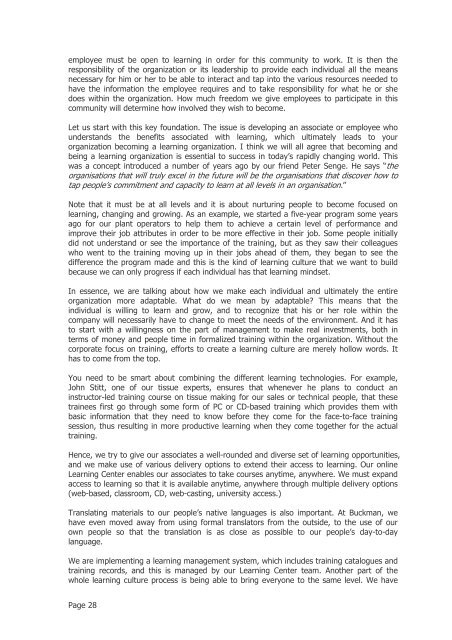Knowledge Management: From Brain to Business (PDF 5.5 - Asian ...
Knowledge Management: From Brain to Business (PDF 5.5 - Asian ...
Knowledge Management: From Brain to Business (PDF 5.5 - Asian ...
You also want an ePaper? Increase the reach of your titles
YUMPU automatically turns print PDFs into web optimized ePapers that Google loves.
employee must be open <strong>to</strong> learning in order for this community <strong>to</strong> work. It is then the<br />
responsibility of the organization or its leadership <strong>to</strong> provide each individual all the means<br />
necessary for him or her <strong>to</strong> be able <strong>to</strong> interact and tap in<strong>to</strong> the various resources needed <strong>to</strong><br />
have the information the employee requires and <strong>to</strong> take responsibility for what he or she<br />
does within the organization. How much freedom we give employees <strong>to</strong> participate in this<br />
community will determine how involved they wish <strong>to</strong> become.<br />
Let us start with this key foundation. The issue is developing an associate or employee who<br />
understands the benefits associated with learning, which ultimately leads <strong>to</strong> your<br />
organization becoming a learning organization. I think we will all agree that becoming and<br />
being a learning organization is essential <strong>to</strong> success in <strong>to</strong>day’s rapidly changing world. This<br />
was a concept introduced a number of years ago by our friend Peter Senge. He says “the<br />
organisations that will truly excel in the future will be the organisations that discover how <strong>to</strong><br />
tap people’s commitment and capacity <strong>to</strong> learn at all levels in an organisation.”<br />
Note that it must be at all levels and it is about nurturing people <strong>to</strong> become focused on<br />
learning, changing and growing. As an example, we started a five-year program some years<br />
ago for our plant opera<strong>to</strong>rs <strong>to</strong> help them <strong>to</strong> achieve a certain level of performance and<br />
improve their job attributes in order <strong>to</strong> be more effective in their job. Some people initially<br />
did not understand or see the importance of the training, but as they saw their colleagues<br />
who went <strong>to</strong> the training moving up in their jobs ahead of them, they began <strong>to</strong> see the<br />
difference the program made and this is the kind of learning culture that we want <strong>to</strong> build<br />
because we can only progress if each individual has that learning mindset.<br />
In essence, we are talking about how we make each individual and ultimately the entire<br />
organization more adaptable. What do we mean by adaptable? This means that the<br />
individual is willing <strong>to</strong> learn and grow, and <strong>to</strong> recognize that his or her role within the<br />
company will necessarily have <strong>to</strong> change <strong>to</strong> meet the needs of the environment. And it has<br />
<strong>to</strong> start with a willingness on the part of management <strong>to</strong> make real investments, both in<br />
terms of money and people time in formalized training within the organization. Without the<br />
corporate focus on training, efforts <strong>to</strong> create a learning culture are merely hollow words. It<br />
has <strong>to</strong> come from the <strong>to</strong>p.<br />
You need <strong>to</strong> be smart about combining the different learning technologies. For example,<br />
John Stitt, one of our tissue experts, ensures that whenever he plans <strong>to</strong> conduct an<br />
instruc<strong>to</strong>r-led training course on tissue making for our sales or technical people, that these<br />
trainees first go through some form of PC or CD-based training which provides them with<br />
basic information that they need <strong>to</strong> know before they come for the face-<strong>to</strong>-face training<br />
session, thus resulting in more productive learning when they come <strong>to</strong>gether for the actual<br />
training.<br />
Hence, we try <strong>to</strong> give our associates a well-rounded and diverse set of learning opportunities,<br />
and we make use of various delivery options <strong>to</strong> extend their access <strong>to</strong> learning. Our online<br />
Learning Center enables our associates <strong>to</strong> take courses anytime, anywhere. We must expand<br />
access <strong>to</strong> learning so that it is available anytime, anywhere through multiple delivery options<br />
(web-based, classroom, CD, web-casting, university access.)<br />
Translating materials <strong>to</strong> our people’s native languages is also important. At Buckman, we<br />
have even moved away from using formal transla<strong>to</strong>rs from the outside, <strong>to</strong> the use of our<br />
own people so that the translation is as close as possible <strong>to</strong> our people’s day-<strong>to</strong>-day<br />
language.<br />
We are implementing a learning management system, which includes training catalogues and<br />
training records, and this is managed by our Learning Center team. Another part of the<br />
whole learning culture process is being able <strong>to</strong> bring everyone <strong>to</strong> the same level. We have<br />
Page 28
















